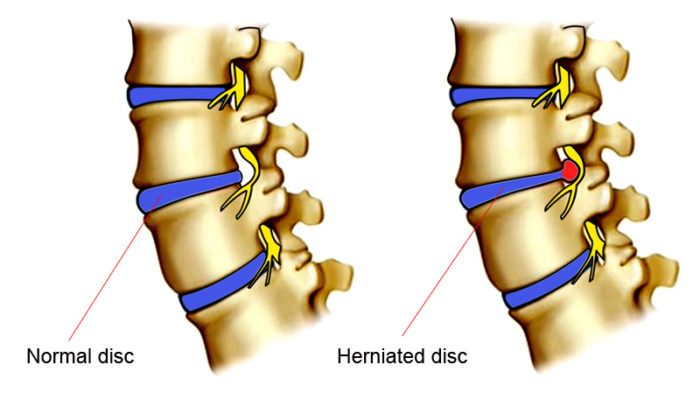
Herniated discs can cause a variety of different symptoms, but those symptoms can vary depending on where the disc herniation occurs in your spine. Below, we take a closer look at the symptoms of herniated discs based on where they develop in your back.
For those of you unfamiliar with the sections of your spine, it can be broken down into three segments: The cervical, thoracic and lumbar portions of your spine.
- Cervical. The cervical portion of your spine involves the first seven vertebrae at the top of your spine near your neck.
- Thoracic. Below the cervical spine is the thoracic portion of your spine, which is home to the next 12 vertebrae.
- Lumbar. Underneath the thoracic spine sits the lumbar portion of your spine, which involves the next five vertebrae.
Since the vast majority of herniated discs occur either at the cervical or lumbar level, those are the two areas we’ll be focusing on below.
Herniated Discs in the Cervical Spine
Herniated discs in the cervical portion of your spine are less common than in the lumbar portion of the spine because there are less disc material and much less force applied to the disc in the cervical area compared to the lumbar portion. You put a decent amount of pressure on your cervical spine when you’re hunched over looking at your phone, but it’s your lumbar spine that absorbs the majority of the force when you bend over to pick something up or you twist and turn your body during athletic competition.
Symptoms of a herniated disc in the cervical spine differ based on the degree of herniation and the specific vertebrae in question. For example, herniation of a cervical disc will generally involve some nerve compression or impingement, and which nerves are compressed will dictate your symptoms. Compression at the C4 or C5 disc level can contribute to regionalized pain, shoulder pain or muscle weakness in the upper arms, while impingement at the C6 or C7 level can cause numbness in your fingers, weakened grip strength or pain that radiates down your arm.
If your symptoms are generally expressed on the upper portion of your body, like your shoulders, arms, and hands, there’s a good chance that the disc herniation is housed in the cervical portion of your spine.
Herniated Discs in the Lumbar Spine
The most common type of herniated disc is one that develops in the lumbar spine. As you might have guessed based on its location, a disc herniated in the lower part of your spine generally affects your lower body extremities.
For example, a herniated disc at the L4 or L5 level typically involves nerve root impingement of nerves that radiate down your leg, meaning you may experience leg weakness, inhibited gait or pain that radiates down your leg, especially during movement. You may also notice weakness or numbness in your feet and toes. A more serious problem associated with a herniated disc in the lumbar spine includes bladder problems, like the inability to hold or release urine. These symptoms should be examined by a doctor immediately.
Treating Herniated Discs
The majority of herniated discs will heal without surgery, but that doesn’t mean you should skip out on visiting a spine specialist. They’ll be able to conduct a physical exam, diagnose the location of the herniation and set you up with a specific care plan. Some common conservative treatments include:
- Rest
- Over-the-counter pain medication
- Physical therapy
- Stretching exercises
- Corticosteroid injections
If conservative care fails, surgery can be performed to remove the problemed disc. Surgery has a high success rate but is typically only considered if conservative care fails. For more information about your options for a herniated disc, consult with a local spine specialist.
Precision Pain Care and Rehabilitation has two convenient locations in Richmond Hill – Queens and New Hyde Park – Long Island. Call the Richmond Hill office at (718) 215-1888, or (516) 419-4480 for Long Island office, to arrange an appointment with our Interventional Pain Management Specialist, Dr. Jeffrey Chacko.













